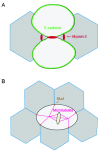Recent advances in cytokinesis: understanding the molecular underpinnings
- PMID: 30542616
- PMCID: PMC6259594
- DOI: 10.12688/f1000research.16502.1
Recent advances in cytokinesis: understanding the molecular underpinnings
Abstract
During cytokinesis, the cell employs various molecular machineries to separate into two daughters. Many signaling pathways are required to ensure temporal and spatial coordination of the molecular and mechanical events. Cells can also coordinate division with neighboring cells to maintain tissue integrity and flexibility. In this review, we focus on recent advances in the understanding of the molecular underpinnings of cytokinesis.
Keywords: ESCRTIII; FtsZ; NoCut; cytokinesis; myosin.
Conflict of interest statement
No competing interests were disclosed.No competing interests were disclosed.No competing interests were disclosed.
Figures



Similar articles
-
Beyond force generation: Why is a dynamic ring of FtsZ polymers essential for bacterial cytokinesis?Bioessays. 2017 Jan;39(1):1-11. doi: 10.1002/bies.201600179. Epub 2016 Nov 7. Bioessays. 2017. PMID: 28004447 Free PMC article. Review.
-
Cytokinetic abscission: molecular mechanisms and temporal control.Dev Cell. 2014 Dec 8;31(5):525-38. doi: 10.1016/j.devcel.2014.11.006. Dev Cell. 2014. PMID: 25490264 Review.
-
Cell Division in genus Corynebacterium: protein-protein interaction and molecular docking of SepF and FtsZ in the understanding of cytokinesis in pathogenic species.An Acad Bras Cienc. 2018 Aug;90(2 suppl 1):2179-2188. doi: 10.1590/0001-3765201820170385. Epub 2018 Feb 15. An Acad Bras Cienc. 2018. PMID: 29451601
-
The Abscission Checkpoint: Making It to the Final Cut.Trends Cell Biol. 2017 Jan;27(1):1-11. doi: 10.1016/j.tcb.2016.10.001. Epub 2016 Oct 31. Trends Cell Biol. 2017. PMID: 27810282 Review.
-
Mechanical stress and network structure drive protein dynamics during cytokinesis.Curr Biol. 2015 Mar 2;25(5):663-70. doi: 10.1016/j.cub.2015.01.025. Epub 2015 Feb 19. Curr Biol. 2015. PMID: 25702575 Free PMC article.
Cited by
-
Switching from weak to strong cortical attachment of microtubules accounts for the transition from nuclear centration to spindle elongation in metazoans.Heliyon. 2024 Feb 5;10(3):e25494. doi: 10.1016/j.heliyon.2024.e25494. eCollection 2024 Feb 15. Heliyon. 2024. PMID: 38356608 Free PMC article.
-
IRX3/5 regulate mitotic chromatid segregation and limb bud shape.Development. 2020 Oct 5;147(19):dev180042. doi: 10.1242/dev.180042. Development. 2020. PMID: 32907847 Free PMC article.
-
Using Live-Cell Imaging and Synthetic Biology to Probe Directed Migration in Dictyostelium.Front Cell Dev Biol. 2021 Oct 5;9:740205. doi: 10.3389/fcell.2021.740205. eCollection 2021. Front Cell Dev Biol. 2021. PMID: 34676215 Free PMC article. Review.
-
A Protein Kinase Cε/Protein Kinase D3 Signalling Axis Modulates RhoA Activity During Cytokinesis.Biomedicines. 2025 Feb 3;13(2):345. doi: 10.3390/biomedicines13020345. Biomedicines. 2025. PMID: 40002758 Free PMC article.
-
The lectin Discoidin I acts in the cytoplasm to help assemble the contractile machinery.J Cell Biol. 2022 Nov 7;221(11):e202202063. doi: 10.1083/jcb.202202063. Epub 2022 Sep 27. J Cell Biol. 2022. PMID: 36165849 Free PMC article.
References
Publication types
MeSH terms
Substances
Grants and funding
LinkOut - more resources
Full Text Sources

